Introduction
For 60 years the world has faced no greater threat than nuclear weapons. Japan, as a nuclear victim country, with “three non-nuclear principles” (non-production, non-possession, and non-introduction of nuclear weapons into Japan) and its “Peace Constitution,” had unique credentials to play a positive role in helping the world find a solution, yet its record has been consistently pro-nuclear, that is to say, pro-nuclear energy, pro-the nuclear cycle, and, pro-nuclear weapons. This paper elaborates on Japan’s aspiration to become a nuclear state, arguing that attention should be paid to Rokkasho, Tsuruga, and Hamaoka, the places at the heart of Japan’s present and future nuclear plans, no less than to Hiroshima and Nagasaki, whose names represent the horror of its nuclear past.[1]
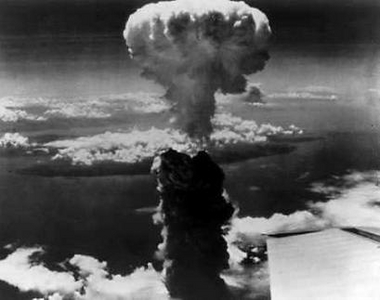
Smoke billows over Nagasakiafter the atomic bomb was dropped on the city in this August 9, 1945 photo.
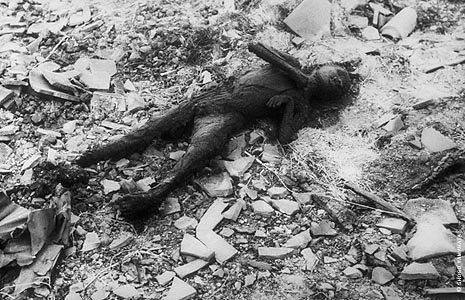
Nagasaki after the bombing
The nuclear question in relation to Japan is commonly understood in the narrow sense of whether Japan might one day opt to produce its own nuclear weapons. Prime Minister Kishi, in 1957, is known to have favored nuclear weapons. In 1961, Prime Minister Ikeda told US Secretary of State Dean Rusk that there were proponents of nuclear weapons in his cabinet, and his successor, Sato Eisaku, in December 1964 (two months after the first Chinese nuclear test) told Ambassador Reischauer that “it stands to reason that, if others have nuclear weapons, we should have them too.” US anxiety led to the specific agreement the following year on Japan’s inclusion within the US “umbrella.”[2] Prime Ministers Ohira, in 1979, and Nakasone, in 1984, both subsequently stated that acquiring nuclear weapons would not be prohibited by Japan's peace constitution - provided they were used for defense, not offence.[3] In the late 1990s, and with North Korea clearly in mind, the Chief of the Defence Agency, Norota Hosei, announced that in certain circumstances Japan enjoyed the right of “pre-emptive attack.”[4] In other words, if the government so chose it could invoke the principle of self-defence to launch a pre-emptive attack on North Korean missile or nuclear or related facilities.
The former Defence Agency’s then parliamentary Vice-Minister, Nishimura Shingo, carried this even further by then putting the case for Japan to arm itself with nuclear weapons.[5] Trial balloons about Japan developing its own nuclear weapons have been floated from time to time. Abe Shinzo, at the time Deputy Chief Cabinet secretary, remarked in May 2002 that the constitution would not block Japan’s production of nuclear weapons provided they were small.[6] North Korea’s declaration of itself as a nuclear power in 2005 and its 2006 launch of missiles into the East Sea (Japan Sea) further stirred these calls. Should the North Korean crisis defy diplomatic resolution, and North Korea’s position as a nuclear weapon country be confirmed, such pressures would become almost irresistible. Even with that crisis resolved, as now seems increasingly possible, the attraction for Japanese politicians of nuclear weapons as symbol of great power status has an ominous aspect.
However, I argue that a much broader construction of nuclear threat should be adopted. Japan is simultaneously unique nuclear victim country and one of the world’s most nuclear committed - one might almost say nuclear obsessed - countries. Protected and privileged within the American embrace, it has evolved into a nuclear-cycle country and plutonium super-power. Plutonium is the chosen material on which the future of the Japanese economy is to rest – a material that only came to exist because of its destructive potential and that is so dangerous to humanity that a teaspoon-sized cube of it would suffice to kill 10 million people: today Japan contemplates with apparent equanimity a future in which it accumulates virtual mountains of the stuff.
Criticism of Japan tends, in general, to concentrate on its past crimes and present cover ups, ie on past history. Yet the bureaucratic project to convert Japan into a plutonium-dependent superpower surely concerns the region and the world. And where Japan goes, Asia and the world commonly follow.
Weapons
So far as defense policy is concerned, Japan is unequivocal: the core of its defense policy is nuclear weapons. To be sure, the weapons are American rather than Japanese, but their nationality is immaterial to their function, the defense of Japan. The nuclear basis of defense policy has been spelt out in many government statements, from the National Defense Program Outline (1976) and “Guidelines for U.S.-Japan Defense Cooperation (1997) to the 2005-6 agreements on “U.S.-Japan Alliance: Transformation and Realignment for the Future.”[7]
So supportive has Japan been of American nuclear militarism that in 1969 it entered secret clauses into its agreement with the United States so that the “principles” could be bypassed and a Japanese “blind eye” turned towards American vessels carrying nuclear weapons docking in or transiting Japan, an arrangement that lasted until 1992.[8] Thereafter, nuclear weapons continued to form the kernel of US security policy, without Japanese demur, but there was no longer any need to stock them in Japan or Korea since they could be launched at any potential target, such as North Korea, from submarines, long-range bombers, or missiles. In 2002, the US articulated the doctrine of preemptive nuclear attack, under Conplan 8022. Conplan 8022-02, completed in 2003, spelled out the specific direction of preemption against Iran and North Korea.[9] By embracing an “alliance” with the US, Japan also embraces nuclear weapons and nuclear preemption.
Japan’s position in denouncing the nuclear program of North Korea rests on the distinction between its “own,” i.e. American nuclear weapons, which are “defensive” and therefore virtuous, and North Korea’s, which constitute a “threat” and must be eliminated. Yet logically, if Japan’s security – and the security of the nuclear powers themselves - can only be assured by nuclear weapons, the same should apply to North Korea, whose case for needing a deterrent must anyway be stronger than Japan’s. Mohammed ElBaradei, Director-General of the International Atomic Energy Agency (IAEA), criticizes as “unworkable” precisely such an attempt to separate the ”morally acceptable” case of reliance on nuclear weapons for security (as in the case of the US and Japan) and the “morally reprehensible” case of other countries seeking to develop such weapons (Iran and North Korea).”[10]
The moral and political coherence of Japan’s Cold War nuclear policy depended on the one hand on reliance on the US “Umbrella” and on the other on support for non-proliferation and nuclear disarmament under the Non-Proliferation Treaty, but as the US, and indeed other nuclear club powers (Britain, Russia, France, China) made clear their determination to ignore the obligation they entered under Article 6 of the 1970 Non-Proliferation Treaty, and reaffirmed in 2000 as an “unequivocal undertaking,” for “the elimination of their nuclear arsenals,” the policy was steadily hollowed out. As the dominant Western powers turn a blind eye to the secret accumulation of a huge nuclear arsenal on the part of a favored state (Israel) that refuses to join the NPT, so they tend to treat Japan too as a special case, extending it nuclear privileges for reprocessing partly because of its nuclear victim credentials and partly because they are well aware that it is Washington’s favorite son. Partly, too, perhaps because of its pacifist constitution.

Nuclear Umbrella
Over time, like the nuclear powers themselves, once having embraced the weapons Japan paid less and less attention to getting rid of them. Its cooperation in the projection of nuclear intimidation against North Korea contributed to proliferation and brought closer the time when Japan itself might decide to possess its own weapons. Should it make such a decision, Japan already possesses a prototype intercontinental ballistic missile, in the form of its H2A rocket capable of lifting a five-tonne payload into space, huge stores of plutonium and high levels of nuclear scientific and technical expertise.[11] No country could match Japan as a potential member of the nuclear weapon club.
Needless to say, countries such as Japan that choose to base their national policy on “shelter” beneath the US umbrella identify themselves with that umbrella’s threatening as well as its defensive function. It is a system within which Japan is steadily incorporated, despite the almost total absence of public debate. Japan’s leaders appear to embrace their compliant nuclear status without apparent qualm.
While Japan seems to have no qualms about the nature of the “umbrella” under which it shelters, the US has been plainspoken on its determination not to rule out first use of its nuclear force. The Pentagon’s “Global Strike Plan,” drawn up in response to a January 2003 classified directive from the President, integrated nuclear weapons with “conventional” war fighting capacity and made clear the reservation of right of preemption.[12] What that might mean for Korea (and for the region) beggars the imagination. According to a 2005 study by the South Korean government, the use of US nuclear weapons in a “surgical” strike on North Korea’s nuclear facilities would, in a worst case scenario, make the whole of Korea uninhabitable for a decade, and if things worked out somewhat better, kill 80 per cent of those living within a ten to fifteen kilometer radius in the first two months and spread radiation over an area stretching as far as 1,400 kilometers, including Seoul.[13]
The US, that with Japan’s support in March 2003 launched a devastating war on Iraq based on a groundless charge that that country was engaged in nuclear weapons production, maintains its own arsenal of around 7,500 warheads, most of them “strategic” and more powerful than the ones that destroyed Hiroshima and Nagasaki. It now works on a replacement schedule to produce 250 new “reliable replacement warheads” per year, makes great efforts to develop a new generation of “low yield” small nuclear warheads, known as “Robust Nuclear Earth Penetrators” or “bunker busters” specially tailored to attack Iranian or North Korean underground complexes, deploys shells tipped with depleted uranium that spread deadly radioactive pollution likely to persist for centuries, has withdrawn from the Anti Ballistic Missile Treaty (ABM) and declared its intent not to ratify the Comprehensive Test-Ban Treaty (CTBT), and promises to extend its nuclear hegemony over the earth to space.
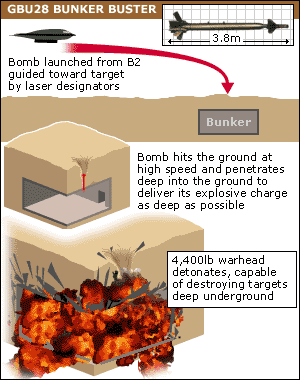
Bunker Buster
Robert McNamara, who used to run the American system, in March 2005 described it as “illegal and immoral.”[14] Even though civil nuclear energy cooperation with a non-signatory (especially a nuclear weapons country) contravenes the very essence of the NPT, in 2005 the US also lifted a thirty-year ban on sales of civilian nuclear technology to India, describing it as “a responsible state with advanced nuclear technology.” It roundly denounces Iran and North Korea, on the other hand, for their insistence on a right guaranteed for them in Article 4 of the NPT.
Energy
So much for weapons, what of energy?
The Japan of “non-nuclear principles” is also in process of becoming a nuclear superpower, the sole “non-nuclear” state that is committed to possessing both enrichment and reprocessing facilities, as well as to developing a fast-breeder reactor.
Japan’s Atomic Energy Commission drew up its first plans as early as 1956, and the fuel cycle and fast breeder program were already incorporated in the 1967 Long-Term Nuclear Program. The dream of energy self-sufficiency has fired the imagination of successive governments and generations of national bureaucrats. Trillions of yen have been channeled into nuclear research and development programs. The lion’s share of national energy Research and Development (64 per cent) goes on a regular basis to the nuclear sector and additional vast sums, already well in excess of two trillion yen, have been appropriated to construct and run major centers such as the Rokkasho nuclear complex.[16]
Nuclear power at present makes a modest and declining contribution to world energy needs, 17 per cent in 1993 declining to 16 per cent by 2003. Just to maintain existing nuclear generation capacity globally, it would be necessary to commission about 80 new reactors over the next ten years (one every six weeks) and a further 200 over the decade that followed.[17] To double the nuclear contribution to the global energy, bringing it to about one-third of the total, a new reactor would have to be built each week from now to 2075.[18] The head of the French government’s nuclear energy division, speaking to the April 2006 Congress of the Japan Nuclear Industry Association at Yokohama, estimated that in order to raise global reliance on nuclear power from its present six per cent to 20 per cent by mid-century (ie, a modest increase) it would be necessary to construct between 1,500 and 2,000 new reactors globally.[19] Even such a mammoth undertaking, trebling current nuclear capacity, would still constitute only a modest contribution to solving global energy problems.
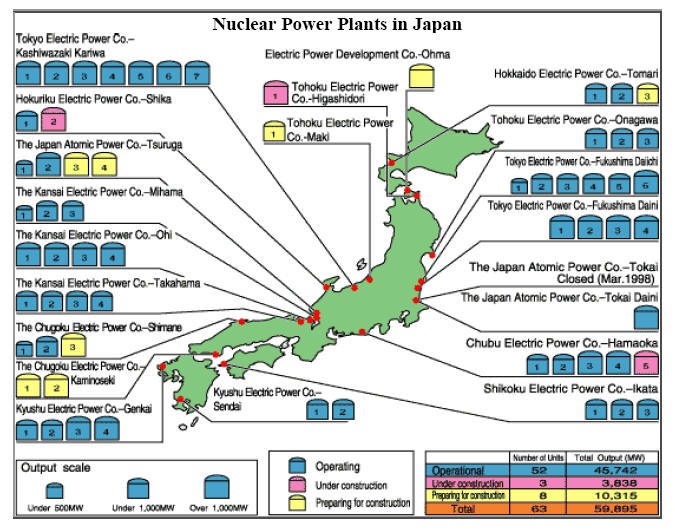
Nuclear Power Plants in Japan, 2006
Of that sort of commitment, there is at present virtually no sign. Of leading nuclear countries, for example, the United Kingdom had more than 40 reactors, but closures were set to cut that to a single one by the mid-2020s, and the US, though it had 100 reactors, was also expected to decommission many of them during the 2020s.[20] The Bush administration has opened a determined push to reverse this trend, of which more later. At present, there are 440 reactors operating worldwide, with 28 more under construction and 30 more promised by 2030 in China.[21] The US has 103, France 59, Japan 55 (29% of its power). Despite the near catastrophes at Three Mile Island (1979) and Chernobyl (1986), not to mention Japan’s own series of serious incidents, Japan alone has steadily stepped up its nuclear commitment, increasing is number of reactors from 32 in 1987 to 55 now with 10 more planned.
Japan, nevertheless, is intent on playing a leading role in pioneering a hitherto unprecedented level of nuclear commitment. Central to the Japanese vision of a nuclear future is the village of Rokkasho in Aomori prefecture. Rokkasho encapsulates perhaps more than anywhere Japan’s transition over the past century from agricultural and fishing tradition, via a traumatic burst of construction state excesses to the full embrace of the nuclear state. Initially a remote provincial community, a vast stretch of land, over 5,000 hectares and still at that time relatively untouched by industrialization, was set aside in 1971 under the Shinzenso or Comprehensive National Development Plan as one of eleven gigantic development sites, designated host to petrochemical, petroleum refining, electricity generation and non-ferrous metal smelting on a scale exceeding anything then known in Japan. In due course, the oil shocks and consequent industrial restructuring saw the fading of the dream of an industrial complex idea, and instead large-scale oil storage facilities were set up on part of the site from 1979, and the Rokkasho nuclear enrichment, reprocessing and waste facilities, which took up about one-third of the original site, from 1985. Local government officials had no enthusiasm for the nuclear course, but the deeper they sank into financial dependence the more difficult they found it to oppose plans generated in Tokyo. A 240 billion yen accumulated debt was written off with an infusion of taxpayer money in 2000. Until 2005, hopes were high that the International Thermonuclear Experimental Reactor (ITER) might be built there, but that hope too in time collapsed when the project was allocated to France.[22] The prospect in the early 21s century was one that nobody in the village dreamed of in 1971 – of becoming a center of the global nuclear industry.
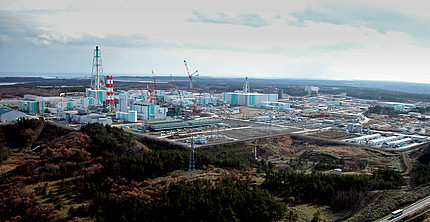
Aerial view of Rokkasho
Despite the early 21st century Japanese government’s mantra of privatization and deregulation, huge sums were poured into nuclear projects which would never have started, much less been sustained, by market forces. While public and political attention focused in 2005 on the privatization of the Post Office, bureaucrats far removed from public scrutiny, accounting or debate were taking decisions of enormous import for Japan’s future, cosseting the nuclear industry and giving it trillions.
Japan’s renewable energy sector (solar, wind, wave, biomass, and geothermal, excluding large-scale hydropower), constitutes a miserable 0.3 per cent of its energy generation, planned to rise over the next ten years to 1.35 but then to decline slightly by 2030. By contrast, even China plans to double its natural energy output to 10 per cent by 2010 and the EU has a target of 20 per cent by 2020.[23] In short, Japan stands out as a country following a course radically at odds with the international community, driven by bureaucratic direction rather than market forces, much less democratic consensus.
The Nuclear State – Waste, Fast Breeding, and the Magic Cycle
By 2006, the objective set out in the Ministry of Economics, Trade, and Industry (METI)’s “New National Energy Policy” was to turn Japan into a “nuclear state” (genshiryoku rikkoku), with the level of nuclear-generated electricity to be steadily raised, to “between 30 to 40 per cent” by 2030 (as against 80 per cent in France as of 2006, the world’s No 1 nuclear country).[24] Other reports suggest the goal of 60 per cent by 2050.[25] In August 2006, METI’s Advisory Committee on Energy Policy produced its draft “Report on Nuclear Energy Policy: Nuclear Power Nation Plan.”[26] Its “Hiroshima Syndrome” would be put behind it, and inhibitions about safety, radiation, waste disposal, and cost cast to the wind as Japan the once nuclear victim sets out to become a nuclear super-state.
Japan’s nuclear energy commitment currently does not particularly stand out in terms of its scale, but among non-nuclear weapon states, it alone pursues the full nuclear cycle, in which plutonium would be used as fuel after the reprocessing of spent reactor waste. It is this bid for plutonium super-power status that distinguishes it. Already with stocks of plutonium amounting to more than 45 tonnes,[27] almost one fifth of the global stock of civil plutonium of 230 tonnes [28] and the equivalent of 5,000 Nagasaki-type weapons, it has become “the world’s largest holder of weapons-usable plutonium,”[29] and its stockpile grows steadily. Barnaby and Burnie estimated in 2005 that Japan’s stockpile on current trends would reach 145 tonnes by 2020, in excess of the plutonium in the US nuclear arsenal.[30] Japan therefore ignored the February 2005 appeal from the Director-General of the International Atomic Energy Agency (IAEA) for a five-year freeze on all enrichment and reprocessing works, arguing that such a moratorium was applicable only to “new” project, not ones such as Japan’s that had been under way for decades.[31]
Currently (2007), Japan is commencing full commercial reprocessing at Rokkasho. It undertakes with impunity what ElBaradei sees as highly dangerous activity that should be placed under international supervision and strictly limited, doing so in defiance of the international community but with the positive blessing of the US. Countries such as Iran and North Korea are told they must absolutely be stopped from doing the same thing (and indeed countries such as South Korea are also blocked from following Japan down the enrichment and recycling path). If Iran and North Korea are a threat to global non-proliferation, then so is Japan. Its forty-five tonnes of plutonium may be compared with the 10 to 15 kilograms of fissile material that North Korea was accused of illicit diversion in the 1994 crisis (or the maximum of around 60 kilograms it might possess in 2007).[32]
The Federation of Electric Power Companies puts the figure of 19 trillion yen on the cost of the Rokkasho facility over the projected forty-year term of its use.[33] That would make it certainly Japan’s, if not the world’s, most expensive facility in modern history. Experts point out that it would cost very much less to bury the wastes, unprocessed (provided, that is, there is some place to bury them…), and fear that the actual cost might climb to several times the official estimate.[34] Rokkasho’s reprocessing unit is supposedly capable of reprocessing eight hundred tons of spent fuel per annum, yielding each year about eight more tons (1,000 warheads-worth) of pure, weapons-usable plutonium.[35] Even such a plant, however, though it would be the only one in Asia, would make little more than a small dint in Japan’s accumulated and accumulating wastes, estimated at approximately 12,600 tonnes as of 2006,[36] let alone the 40,000 tonnes of toxic nuclear spent fuel wastes so far accumulated throughout Asia.[37]
As it gets going, Rokkasho is about to release the equivalent of the nuclear wastes of 1,300 power stations.[38] The tritium discharge level will be 7.2 times that of Sellafield in Northern England, recently closed by the British Government. The operation of the Sellafield plant, and the wastes it poured into supposedly deep sea currents for dispersal, led over decades to fish devastation across much of the Irish Sea and leukemia levels in children 42 times the national average as far away as Carnarvon in Wales.[39] In Rokkasho, the plant operators have secured a permitted level of tritium release at 2,800 times that permitted for conventional reactors, essential to the plant’s economic viability, and although said to be dispersing its wastes into deep ocean currents, an opposition group scattered postcards into the Rokkasho sea which later turned up right along the Japanese coast, through Iwate, Miyagi, Fukushima to Ibaraki and Chiba prefectures.[40]

Gloved hands holding a "button" of plutonium.
What then will Japan do with its plutonium mountain? To address the general perception that it is the most dangerous substance known to mankind, in the 1990s it undertook two steps. First, it issued an assurance that it would neither stockpile nor hold more than was necessary for commercial use. From the beginning that pledge was empty. The stockpile grew steadily because of the many delays to the plans, due largely to the many accidents (including those causing fatalities),[41] cover-ups[42] and continual budget over-runs that galvanized public opposition to proposed projects.[43] Even if Rokkasho was to function for forty years, without delays and technical problems, processing without hitch 800 tonnes of spent fuel per year, spent fuel volumes will continue to grow. Japan’s nuclear reactors are currently discharging each year 900 tonnes of waste, about 100 more than can be reprocessed by a fully functioning Rokkasho reprocessing plant. This figure is set to reach between 1,200-1,400 tonnes by 2015 as more reactors are commissioned that will mean the accumulation of 400-600 tonnes over and above what can be reprocessed, most of which will remain stored at reactor sites or at proposed regional interim storage sites.[44] That would be added to the current global stockpile of separated plutonium (ca 250 tonnes)[45] with the gap widening further if, or as, more reactors are built.[46]
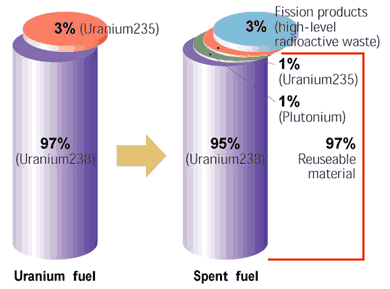
Nuclear waste to be stored at Rokkasho for 30-50 years
Second, the government launched a campaign to persuade the public that there was no need to worry about plutonium. The Japanese Power Reactor and Nuclear Fuel Corporation issued an informational video featuring a character, Mr Pluto, who declared that plutonium was safe enough to drink, which he demonstrates, and that there was little risk of it being turned into bombs.[47] When the US Energy Secretary, among others, protested at the video’s inaccuracies, it was withdrawn, but the advertising campaign continued.
Till 1995, the plan was to operate fast-breeder reactors, which “breed” (i.e. produce more than they start with) plutonium of very pure, “super-grade” plutonium. Such programs make little economic sense, since they cost four to five times as much as conventional power plants, and most projects around the world, including the US and UK, have been abandoned on grounds of either safety or cost.[48] The Japanese Citizens’ Nuclear Information Center judges that they are “completely incompatible with non-proliferation.”[49] Japanese plans were thrown into disarray by the shut-down of the Monju prototype fast-breeder reactor (at Tsuruga, in Fukui Prefecture on the Japan Sea coast) after a sodium leak and fire in December 1995, followed by evidence of negligence and cover-up and the project was suspended for almost ten years. Opponents of the project after years of protest won a court victory upholding their stance that the design of the reactor was flawed. In May 2005, however, the Supreme Court overturned that ruling and upheld the government’s decision to proceed. By then, over 30 years the project had cost already 600 billion yen while not having lit a single light bulb. Under current government plans, the fast breeder is to be commercialized by 2050, a remarkable 70 years behind its original schedule.[50]
Undaunted, the JAEA has set up in Tsuruga something called an Aquatom – science museum, theme park, community centre – designed to brush off the near disaster and persuade people that this is the future. Display panels explain to visitors that the world has only 40 years of oil left, 65 of natural gas, 155 of coal, and only 85 of uranium for conventional nuclear plants.
“Japan is a poor country in natural resources … therefore Monju, a plutonium burning reactor, is necessary because plutonium can be used for thousands of years.”[51]
Money continues to flow into Tsuruga local projects, including those in welfare and tourism promotion. The spirit of Mr Pluto is alive and well in Aquatom.
Not only is Monju itself to be resuscitated, but a second reactor is also to be built, at a cost of “about 1 trillion yen,” to replace it by around 2030.[52] The bureaucratic dream of energy security for the 21st century operates on a higher plane of logic than economics.
Whatever the outcome of the fast-breeder project, the government also adopted a plan to burn recycled plutonium in conventional light-water reactors in the form of a plutonium-uranium oxide (MOX) fuel.[53] This process is also several times more expensive than low-enriched uranium fuel and it involves much higher risk.
Earlier efforts to start plutonium MOX use in the late 1990’s failed. On current plans, Japan’s utilities would begin to load plutonium fuel from around 2007-8, but on past record it is likely to take longer, and the gap between the production of plutonium (from both European based stocks belonging to Japan and that coming out of Rokkasho) and the ability to load it into reactors will widen further.
The bottom line is that wastes continue to accumulate. Low-level wastes – basically comprising contaminated clothing, tools, filters etc - are held in over one million 200-liter drums both at nation-wide reactor sites and at Rokkasho’s repository, whose projected eventual capacity is for three million drums.[54] Forty vast repositories are planned, each 6 meters high and 24 by 24 meters and containing 10,000 drums, destined, eventually, to be covered in soil, with something like a mountain built over them, after which they must be closely guarded for at least 300 years, slowly spreading, like giant, poisonous mushrooms or the mausolea of ancient Japanese aristocrats, across the Rokkasho site. Meanwhile, fluids containing low levels of radiation are being piped several kilometers out into the Pacific Ocean for discharge, the standards for effluent control in place at reactor sites around the country drastically raised (ie relaxed) in order to make regular discharges possible.[55]
High level toxic wastes, basically spent fuel, have since 1992 been regularly shipped across vast stretches of ocean to reprocessing plants at Sellafield in the north of England and la Hague, Normandy, in France, each shipment equivalent to about seventeen atomic bombs-worth of plutonium, despite the protests of countries en route and the risks of piracy or hijacking.[56] Once processed, the liquid high level waste is vitrified and put in canisters, each 1.3 by 0.43 meters, which are returned to the Rokkasho site, where they are to be stored initially for 30 to 50 years while their surface temperature slowly declines from around 500 degrees centigrade to 200 degrees centigrade, at which point it is planned to bury them in 300 meter deep underground caverns where their radiation will further dissipate over millennia. These canisters already more than half-fill their first giant store house.
As Japan’s reactors reach their “use by” date, they must be decommissioned, dismantled, and the sites cleaned. No one knows exactly what that will cost, but the British authorities early in 2006 calculated 70 billion pounds ($170 billion) for dealing with twenty of their repatriated civil nuclear sites.[57] Whatever the short-term financial inducements on offer from Tokyo, local communities are steadfastly opposed to hosting such facilities and governors balk at the thought of their prefectures being turned into nuclear dumpsites for literally millennia.
However, the determination of the state and nuclear power industry to press ahead with all possible nuclear developments, and the imperative of doing something with the plutonium mountain, constituted powerful, perhaps irresistible forces.
Due to the inadequacy of international nuclear standards, the proliferation hazards associated with reprocessing are greater than most would believe. The best estimates are that a one-percentage loss of fissile materials – or “about a nuclear weapon’s worth a month - in such a vast system of uranium and plutonium processing and transport would be impossible to detect.[58] This feeds further uncertainty on the part of Japan’s neighbors, especially South Korea and China.
While Japan’s government and bureaucracy pursues single-mindedly its chosen nuclear superpower path, the embrace with the US tightens while its distance from Asia widens. In February 2006, Washington included Japan on a short-list of countries for a projected Global Nuclear Energy Partnership (GNEP), a kind of nuclear energy “coalition of the willing” that would include the US, Great Britain, France, Russia, China, and Japan (i.e. the existing nuclear club members, all nuclear weapons states, plus Japan). The world would be divided into “our” states that can be trusted with weapons (Pakistan, India, Israel..) and reprocessing technologies (Japan, and Australia if Prime Minister Howard can have his way) in a system designed to sidestep the existing UN-centered international framework of the 1970 Non-Proliferation Treaty and establish a new cartel to control the production, processing, storage, sale, and subsequent disposal of uranium. Nominally the project is to address global warming and energy needs, but actually it is to address unsolved problem of nuclear wastes, especially Mr Pluto, as hundreds of tonnes of the stuff accumulate worldwide. So difficult to bury it under Yucca Mountain, why not just use it?
By adopting this project, the US was reversing 30 years of policy banning reprocessing because of the proliferation and cost concerns. It would now sponsor the construction of a new generation of reactors, the reprocessing of spent fuel (something that would become ok when conducted by close allies of the US) and create a boondoggle for companies such as General Electric (and presumably also Japanese companies such as Hitachi) with 100s of billions of dollars in construction contracts up for grabs. The project would develop a so-called proliferation-resistant recycling and reactor technology, maintain monopoly control over it, and then offer facilities to the rest of the world on a lease basis.[59]
The Japanese government, long been negatively disposed towards regional attempts to forge a Northeast Asian Nuclear Free Zone, jumped at this American invitation to join a global nuclear superpower club. Australia too, initially taken unawares by the proposal, soon developed enthusiasm. Prime Minister Howard eagerly sought American advice on his visit to Washington three months later,[60] secured the blessings he sought, and issued a call for a national debate on nuclear energy. Australia could expect to play a key role in such a project, mining, manufacturing, selling, and monitoring it for the duration of its cycle, since it is the “Saudi Arabia” of global uranium (Uranium’s No 1, with 24 per cent of global reserves, although it has thus far chosen to remain a quarry for uranium, not itself processing it).[61] The Prime Minister, along with the Defence, Industry, and Environment ministers, have all said that Australia should “consider” the option of a nuclear power industry.[62] The global axis of US power evident in its construction of special relationships with the UK, Australia, and Japan would here take on a nuclear dimension.
The major technology it advocates (advanced burner reactor or ABR) exists only as a theoretical proposition. The principle is the same as the fast neutron fast breeder reactor (to date a colossal, expensive failure), but without the use of a breeder blanket which is where the supergrade plutonium is produced. However, the application of a blanket is as simple one compared to the technical challenge of designing a fast reactor to operate reliably. Commercial scale demonstration of the new, American-proposed technology could not be expected for twenty to twenty-five years.[63] The costs are expected to be enormous. The US Energy Secretary indicates that a fund of between twenty and forty billion dollars will be needed, and implies that a major contribution would be expected from Japan.[64] This requisitioning may in time come even to dwarf the levies imposed on Tokyo to fund its Gulf and Iraq wars, sustain the dollar in international financial markets, and feed the missile defense industry. The wastes would still accumulate.
Above all, the Partnership is based on positive promotion of nuclear as the core source of future global energy, and it would require public investment of the core countries to flow to the most costly and dangerous option, rather than to true renewables. It goes against the trend of global energy markets.
1994-2003 electricity supply increased by: [65]
Wind 30%
Solar 20%
Gas 2%
Coal 1%
Nuclear 0.6%
There are also serious doubts that the world has enough uranium anyway to follow the nuclear course, even if safety and other issues could be met. John Busby calculates that 'primary production would have to be increased 167-fold to match the anticipated global energy needs exclusively from nuclear power in 2020' and, even if nuclear power generation could be doubled - an unlikely proposition - it would be enough to meet only 5 per cent of world energy consumption.[66] This uranium shortfall is used by advocates of fast breeder reactors to justify the development of new designs of breeders despite their failure over the past decades. The agenda of massive expansion, whether of the still-to-be-developed Partnership technologies or of the existing light water reactors, is simply fantastic.
[4] Statement of 3 March 1999 (quoted in Taoka Shunji, “Shuhen yuji no ‘kyoryoku’ sukeru,” Asahi shimbun, 3 March 1999.).










 TOKYO - Plutonium yang beracun tingkat tinggi ditemukan bocor dari pembangkit listrik tenaga nuklir Fukushima Daiichi. Bahan beracun tersebut ditemukan merembes ke lahan disekitar pembangkit listrik tersebut.
TOKYO - Plutonium yang beracun tingkat tinggi ditemukan bocor dari pembangkit listrik tenaga nuklir Fukushima Daiichi. Bahan beracun tersebut ditemukan merembes ke lahan disekitar pembangkit listrik tersebut.